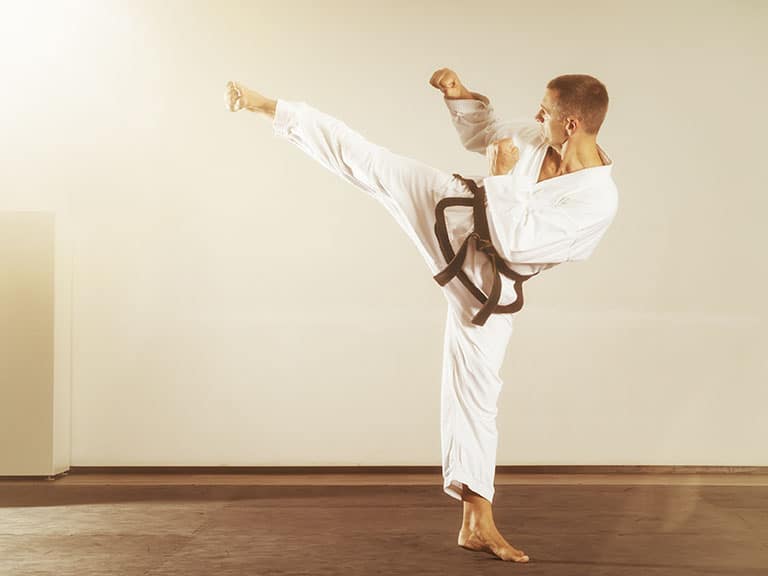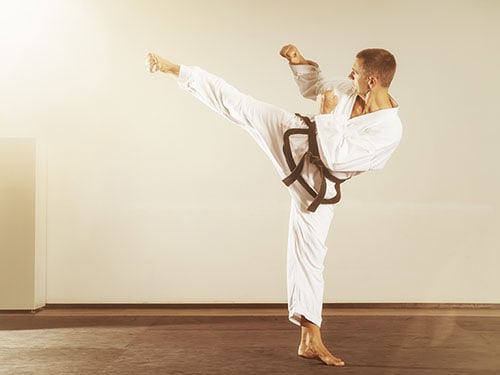
When first starting in Taekwondo, as with most martial arts, building a strong foundation is essential. Mastering these three basic kicks will not only enhance your technique but also help you progress through the belt ranks. This guide covers everything from proper execution to safety tips, common mistakes, and warm-up routines.
The Three Basic Kicks in Taekwondo
The three fundamental kicks are:
- Front Kick – Ap Chagi
- Turning Kick – Dollyo Chagi
- Side Kick – Yeop Chagi
While these kicks may seem basic compared to more advanced techniques, learning them thoroughly makes it easier to build more impressive moves later on.
Fundamental Techniques and How to Practice
Front Kick (Ap Chagi)
The front kick is the most basic and fundamental kick in Taekwondo. When executing a front kick, focus on these key points:
- Technique:
- Lift your knee high, then extend the leg forward with the ball of the foot making contact.
- Keep your hips parallel to ensure the power isn’t lost to the side.
- Training Tips:
- Mix fast and slow-motion kicking to build muscle memory.
- Start by kicking the air for balance and technique, then progress to kicking pads.
- Stance & Execution:
- Begin in a side-on stance, feet two shoulder widths apart, with your kicking leg positioned back and your guard up.
- Drive the rear leg forward as if aiming to knee an opponent, keeping your body upright with weight on the standing foot.
- Extend the kicking leg towards your target, striking with the ball of the foot (toes pulled back).
- Snap the leg back into a flexed position immediately after impact.
- Land the kicking foot forward to either prepare for another move or return to the starting position.
Note: While the demonstration video provides a detailed look at this technique, remember that consistent practice is key.
Turning Kick (Dollyo Chagi)
Often referred to as the “roundhouse” kick, the turning kick is a versatile technique widely practiced in Taekwondo. Emphasize these points for proper execution:
- Technique:
- Begin with a side-on stance, similar to the front kick.
- Drive the rear leg forward, then pivot your standing foot 180 degrees so that your heel faces the target.
- Extend your kicking leg by throwing your hips forward, striking with the instep of your foot.
- Training Tips:
- Snap the leg back quickly after impact to prevent counterattacks.
- Practice with controlled movements to build accuracy and speed.
Note: Although the demonstration video below is not by me (not as young as I used to be!), it provides excellent visual instruction.
Side Kick (Yeop Chagi)
The side kick is often a favorite due to its power and directness. This kick is ideal for targeting the torso and is executed as follows:
- Technique:
- Begin by lifting your knee across your body so that the knife edge of your foot is exposed.
- Turn your standing foot and thrust your kicking foot using the knife edge and heel.
- Training Tips:
- Practice retracting the leg quickly along the same path to avoid counterattacks.
- Maintain balance by keeping your upper body upright and using proper hip rotation.
- Execution Steps:
- Raise your knee and align your body so that the target is directly to your side.
- Turn the standing foot and thrust the kicking foot out using the outer edge.
- Quickly withdraw the leg after full extension to prepare for further movement.
Note: Avoid using the toes for impact to minimize injury risk. The demonstration video here provides an excellent visual guide if you learn easier this way.
Pre-Kicking Essentials
Warm-Up and Flexibility Routines
Before practicing kicks, ensure you perform a proper warm-up to reduce injury risk and improve flexibility. Consider incorporating:
- Dynamic Stretches:
Leg swings, hip rotations, and lunges help prepare your muscles. - Static Stretching:
After training, focus on stretches that target the hamstrings, quadriceps, and hip flexors. - Balance Drills:
Exercises such as single-leg stands and gentle kicks in slow motion improve overall stability.
Common Mistakes and Corrections
Avoid these frequent errors to refine your technique:
- Improper Hip Rotation:
Ensure that your hips rotate fully to maximize the kick’s power. - Low Knee Lift:
A high knee lift is essential for proper extension and balance. - Delayed Retract:
Quickly snapping the leg back is crucial to avoid counterattacks.
Implement corrections by practicing in slow motion and gradually increasing speed as your technique improves.
Safety Tips and Injury Prevention
Practicing Taekwondo kicks safely is paramount. Follow these guidelines:
- Proper Instruction:
Train under a qualified instructor to ensure you are using the correct form. - Controlled Environment:
Use padded surfaces or training pads, especially when practicing new techniques. - Listen to Your Body:
Avoid overtraining and take breaks to prevent joint or muscle injuries. - Use Appropriate Gear:
Consider wearing protective gear, such as shin guards, during sparring sessions.
Parts of the Foot Used for Kicking
Understanding the striking surfaces on your foot is essential for effective kicking. The main parts include:
- Ball of the Foot:
Engaged when toes are pulled back. - Foot Sword:
The outer edge used by turning the foot down. - Heel:
A hard surface ideal for penetrating kicks. - Instep:
The top of the foot, used when toes are pointed forward. - Sole:
Provides a larger surface area for forcing an opponent backward.
Principles of Effective Kicking
Four key principles underpin a strong kicking technique:
- Speed:
Improve by timing your kicks and gradually increasing the pace. - Power and Balance:
Incorporate strength training (squats, lunges, leg pistols) and practice on a heavy bag to enhance power. - Flexibility:
Increased flexibility leads to more effective and faster kicks. - Proper Distance and Hip Rotation:
Adjust your distance for optimal impact and use your hips to extend reach and height.
Training Tips For Kicks
Practice your kicks as if you’re moving in slow motion to perfect your form. Combine footwork and kicking drills, and practice on moving targets—whether with a partner or a suspended ball (tennis balls work great for this purpose). If you’re preparing for competitions, fluid movement and quick transitions are essential.
Final Thoughts
Mastering these basic Taekwondo kicks lays the foundation for more advanced techniques and overall martial arts proficiency. By focusing on proper technique, warming up thoroughly, correcting common mistakes, and prioritizing safety, you’ll be well on your way to excelling in Taekwondo.
Remember, practice and consistency are the keys to mastery. Enjoy your training and continue exploring new techniques to refine your skills.

